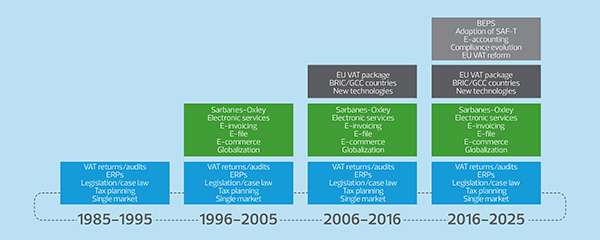With the emergence of internet sales and fast, inexpensive international shipping, it has never been easier for even relatively small companies to develop global markets and, as a consequence, build a global VAT footprint. With overseas VAT rates often in excess of 20 percent and the associated penalty regimes being draconian, the consequences of failing to effectively manage this position can be severe.
This situation has also been complicated by the emergence of new legislation that taxes internet sales of services to consumers, including music and video downloads, online dating services, electronic games, subscription services and online education. As tax authorities around the world continue to apply VAT to such services, an increasing number of businesses are being sucked into the VAT environment, often for the first time. This can be especially difficult where the business has no permanent establishment, people or assets on the ground in the country in question, meaning that they have to manage their VAT affairs from afar.
This complexity has continued to evolve with some more recent requirements focusing on new and more extensive reporting needs, such as the move towards near-real-time reporting. This is a departure from the traditional submission of a monthly VAT return to a more regular transaction reporting structure. For example, Spain now requires that all transactions be reported to the tax authorities within 4 days of the event. Italy and Hungary are moving toward real-time reporting. Poland has announced that it will be abandoning the VAT return format completely and will rely instead on newly introduced transaction reports. We can expect more countries to follow these examples in a bid to reduce tax evasion, enhance revenue collection and realize efficiencies in tax governance. It is becoming increasingly important that businesses follow suit and reinforce their own VAT governance and risk management positions.
For middle market and smaller companies in particular, this situation is exacerbated by the fact that they often have little internal resource available to manage their US tax issues, let alone their global VAT positions. This leaves them open to the possibility of non-compliance, which carries with it the threat of penalties, interest charges and reputational damage. A key challenge is how to efficiently and effectively manage a tax that is present globally while maintaining a compliant profile, providing transparency into their business data, and having strong risk management processes around the whole position. Even larger companies find that they are not able to handle this alone.
So, what are the tasks associated with VAT compliance? The answer to that question can differ between companies and will depend on industry sector and trading profile but most companies will need to manage the following broad areas affecting their VAT position:
- Monitoring the company’s trading activities and each country’s legislation, case law and tax policies to understand where they might need to register for VAT
- Managing the VAT registration process itself
- Communications and language issues when dealing with local tax authorities
- Recognizing the accounting and data requirements for completing and submitting VAT returns and other required reports. This often involves deriving new reports from the business’s financial systems
- Accurate and timely submission of VAT documents
- Audit defense of their VAT position
VAT return processing is often a manually driven, time-consuming process for businesses and can stretch valuable tax resources to the limit. Whether it is a lack of in-house VAT-specific experience or simply insufficient staffing to meet demands, many businesses find that they need to work with an expert partner to achieve an acceptable balance between compliance and risk.
So what are the options available to companies with an international trading footprint? There are three primary paths to compliance in the VAT space.
- In-house management: For middle market businesses, this is often beyond their capabilities, as bringing sufficient expertize in-house can be an expensive and inefficient process;
- Co-sourcing: In this model, the business carries out some accounting functions on the way to completing their VAT returns and compliance reports and then hands that work over to a partner, that is equipped to finish the process and submit the documents to the relevant tax authorities. This relieves the business of some of the effort but does not realize the full synergies of the final option;
- Outsourcing: This model has become the most popular over the last 10 years or more as organizations large and small come to recognize that VAT compliance is rarely a core function or expertize of their finance departments and is beyond their capabilities for risk management purposes.


